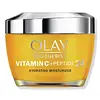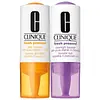What's inside
What's inside
 Key Ingredients
Key Ingredients

 Benefits
Benefits

 Concerns
Concerns

 Ingredients Side-by-side
Ingredients Side-by-side

Water
Skin ConditioningGlycerin
HumectantIsohexadecane
EmollientNiacinamide
SmoothingDimethicone
EmollientLactic Acid
BufferingIsopropyl Isostearate
EmollientSodium Polyacryloyldimethyl Taurate
Emulsion StabilisingStearyl Alcohol
Emollient3-O-Ethyl Ascorbic Acid
Skin ConditioningPalmitoyl Pentapeptide-4
Skin ConditioningPanthenol
Skin ConditioningSodium Lactate
BufferingTrehalose
HumectantCetearyl Glucoside
EmulsifyingCetearyl Alcohol
EmollientBehenyl Alcohol
EmollientCetyl Alcohol
EmollientStearic Acid
CleansingPalmitic Acid
EmollientDimethiconol
EmollientPEG-100 Stearate
Sodium Benzoate
MaskingParfum
MaskingAscorbic Acid
AntioxidantAvena Sativa Peptide
Skin ConditioningWater, Glycerin, Isohexadecane, Niacinamide, Dimethicone, Lactic Acid, Isopropyl Isostearate, Sodium Polyacryloyldimethyl Taurate, Stearyl Alcohol, 3-O-Ethyl Ascorbic Acid, Palmitoyl Pentapeptide-4, Panthenol, Sodium Lactate, Trehalose, Cetearyl Glucoside, Cetearyl Alcohol, Behenyl Alcohol, Cetyl Alcohol, Stearic Acid, Palmitic Acid, Dimethiconol, PEG-100 Stearate, Sodium Benzoate, Parfum, Ascorbic Acid, Avena Sativa Peptide
Water
Skin ConditioningAscorbic Acid
AntioxidantGlycerin
HumectantDimethicone
EmollientSqualane
EmollientButylene Glycol
HumectantDipropylene Glycol
HumectantAcetyl Glucosamine
Skin ConditioningCucumis Sativus Fruit Extract
EmollientHordeum Vulgare Extract
EmollientMorus Nigra Root Extract
Skin ConditioningSaccharum Officinarum Extract
MoisturisingLaminaria Digitata Extract
Skin ProtectingScutellaria Baicalensis Root Extract
AstringentAcetyl Hexapeptide-8
HumectantVitis Vinifera Fruit Extract
Skin ConditioningAlgae Extract
EmollientPalmitoyl Hexapeptide-12
Skin ConditioningPalmitoyl Tripeptide-1
Skin ConditioningPalmitoyl Tetrapeptide-7
Skin ConditioningAlcaligenes Polysaccharides
EmollientCaffeine
Skin ConditioningSucrose
HumectantLactis Proteinum
Skin ConditioningBetaine
HumectantSalicylic Acid
MaskingGlycine Soja Protein
EmulsifyingSodium Hyaluronate
HumectantCaprylyl Glycol
EmollientSigesbeckia Orientalis Extract
Skin ConditioningBis-PEG-18 Methyl Ether Dimethyl Silane
EmollientPropylene Glycol Dicaprate
EmollientHelianthus Annuus Seedcake
AbrasiveAllyl Methacrylates Crosspolymer
Emulsion StabilisingCarbomer
Emulsion StabilisingGlyceryl Polymethacrylate
Tromethamine
BufferingXanthan Gum
EmulsifyingPotassium Sorbate
PreservativePEG-8
HumectantPolysorbate 20
EmulsifyingSodium Citrate
BufferingDisodium EDTA
Phenoxyethanol
PreservativeGlycine Soja Oil
EmollientVinyl Dimethicone/Methicone Silsesquioxane Crosspolymer
Methyl Trimethicone
Skin ConditioningLauryl PEG-9 Polydimethylsiloxyethyl Dimethicone
Skin ConditioningPolysilicone-11
Methyl Gluceth-20
HumectantRetinol
Skin ConditioningOenothera Biennis Flower Extract
AstringentLaminaria Saccharina Extract
Skin ProtectingGelidiella Acerosa Extract
Skin ProtectingCholesterol
EmollientSalvia Sclarea Extract
AntiseborrhoeicAminopropyl Ascorbyl Phosphate
AntioxidantPlankton Extract
Skin ConditioningGlycine Soja Seed Extract
Skin ConditioningMicrococcus Lysate
Skin ConditioningHypnea Musciformis Extract
Skin ProtectingTocopheryl Acetate
AntioxidantSodium Hydroxide
BufferingCalcium Chloride
AstringentAmmonium Acryloyldimethyltaurate/Vp Copolymer
Lecithin
EmollientBHT
AntioxidantSodium Benzoate
MaskingWater, Ascorbic Acid, Glycerin, Dimethicone, Squalane, Butylene Glycol, Dipropylene Glycol, Acetyl Glucosamine, Cucumis Sativus Fruit Extract, Hordeum Vulgare Extract, Morus Nigra Root Extract, Saccharum Officinarum Extract, Laminaria Digitata Extract, Scutellaria Baicalensis Root Extract, Acetyl Hexapeptide-8, Vitis Vinifera Fruit Extract, Algae Extract, Palmitoyl Hexapeptide-12, Palmitoyl Tripeptide-1, Palmitoyl Tetrapeptide-7, Alcaligenes Polysaccharides, Caffeine, Sucrose, Lactis Proteinum, Betaine, Salicylic Acid, Glycine Soja Protein, Sodium Hyaluronate, Caprylyl Glycol, Sigesbeckia Orientalis Extract, Bis-PEG-18 Methyl Ether Dimethyl Silane, Propylene Glycol Dicaprate, Helianthus Annuus Seedcake, Allyl Methacrylates Crosspolymer, Carbomer, Glyceryl Polymethacrylate, Tromethamine, Xanthan Gum, Potassium Sorbate, PEG-8, Polysorbate 20, Sodium Citrate, Disodium EDTA, Phenoxyethanol, Glycine Soja Oil, Vinyl Dimethicone/Methicone Silsesquioxane Crosspolymer, Methyl Trimethicone, Lauryl PEG-9 Polydimethylsiloxyethyl Dimethicone, Polysilicone-11, Methyl Gluceth-20, Retinol, Oenothera Biennis Flower Extract, Laminaria Saccharina Extract, Gelidiella Acerosa Extract, Cholesterol, Salvia Sclarea Extract, Aminopropyl Ascorbyl Phosphate, Plankton Extract, Glycine Soja Seed Extract, Micrococcus Lysate, Hypnea Musciformis Extract, Tocopheryl Acetate, Sodium Hydroxide, Calcium Chloride, Ammonium Acryloyldimethyltaurate/Vp Copolymer, Lecithin, BHT, Sodium Benzoate
 Reviews
Reviews

Ingredients Explained
These ingredients are found in both products.
Ingredients higher up in an ingredient list are typically present in a larger amount.
Ascorbic Acid is is pure Vitamin C. This form makes up the largest amount of vitamin C found naturally in our skin.
Not only is vitamin C great for your overall health and immune system, it also has plenty of benefits on your skin.
Vitamin C is best used for brightening skin. It improves dark spots, acne scars, and hyperpigmentation. This is because it blocks the process of skin darkening when exposed to UV.
Remember: Vitamin C should not replace sunscreen!
Your skin uses vitamin C to build collagen. Collagen is one key component in having a strong skin barrier and plump skin. Vitamin C also plays a role in regulating collagen, thus making it effective in improving wrinkles and fine lines.
Ascorbic acid shows potent antioxidant activity. As an antioxidant, it helps fight free-radicals. Free-radicals are molecules that may damage your skin cells. These antioxidants also protect skin against UV damage.
The best formulations include Vitamin E and/or ferulic acid. These two ingredients help stabilize and provide a boost in the benefits of ascorbic acid. This is because ascorbic acid becomes unstable when exposed to UV and air. In fact, you can tell your ascorbic acid has oxidized when it turns an orange-yellow color.
Ascorbic acid is generally compatible with other ingredients. However, using ascorbic acid with other active ingredients might cause irritation. Two ingredients: copper ions and benzoyl peroxide, will inactivate ascorbic acid completely.
Read more about other types of Vitamin C:
Foods rich with vitamin C include oranges, strawberries, broccoli, bell peppers, and more. When consuming Vitamin C, your skin receives a portion of the nutrients.
Learn more about Ascorbic AcidDimethicone is a type of synthetic silicone created from natural materials such as quartz.
What it does:
Dimethicone comes in different viscosities:
Depending on the viscosity, dimethicone has different properties.
Ingredients lists don't always show which type is used, so we recommend reaching out to the brand if you have questions about the viscosity.
This ingredient is unlikely to cause irritation because it does not get absorbed into skin. However, people with silicone allergies should be careful about using this ingredient.
Note: Dimethicone may contribute to pilling. This is because it is not oil or water soluble, so pilling may occur when layered with products. When mixed with heavy oils in a formula, the outcome is also quite greasy.
Learn more about DimethiconeGlycerin is already naturally found in your skin. It helps moisturize and protect your skin.
A study from 2016 found glycerin to be more effective as a humectant than AHAs and hyaluronic acid.
As a humectant, it helps the skin stay hydrated by pulling moisture to your skin. The low molecular weight of glycerin allows it to pull moisture into the deeper layers of your skin.
Hydrated skin improves your skin barrier; Your skin barrier helps protect against irritants and bacteria.
Glycerin has also been found to have antimicrobial and antiviral properties. Due to these properties, glycerin is often used in wound and burn treatments.
In cosmetics, glycerin is usually derived from plants such as soybean or palm. However, it can also be sourced from animals, such as tallow or animal fat.
This ingredient is organic, colorless, odorless, and non-toxic.
Glycerin is the name for this ingredient in American English. British English uses Glycerol/Glycerine.
Learn more about GlycerinSodium Benzoate is a preservative. It's used in both cosmetic and food products to inhibit the growth of mold and bacteria. It is typically produced synthetically.
Both the US FDA and EU Health Committee have approved the use of sodium benzoate. In the US, levels of 0.1% (of the total product) are allowed.
Sodium benzoate works as a preservative by inhibiting the growth of bacteria inside of cells. It prevents the cell from fermenting a type of sugar using an enzyme called phosphofructokinase.
It is the salt of benzoic acid. Foods containing sodium benzoate include soda, salad dressings, condiments, fruit juices, wines, and snack foods.
Studies for using ascorbic acid and sodium benzoate in cosmetics are lacking, especially in skincare routines with multiple steps.
We always recommend speaking with a professional, such as a dermatologist, if you have any concerns.
Learn more about Sodium BenzoateWater. It's the most common cosmetic ingredient of all. You'll usually see it at the top of ingredient lists, meaning that it makes up the largest part of the product.
So why is it so popular? Water most often acts as a solvent - this means that it helps dissolve other ingredients into the formulation.
You'll also recognize water as that liquid we all need to stay alive. If you see this, drink a glass of water. Stay hydrated!
Learn more about Water